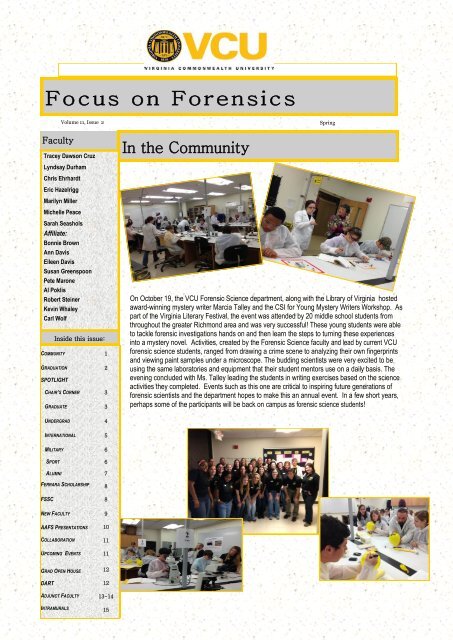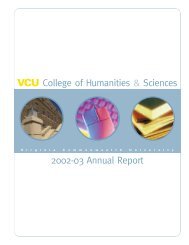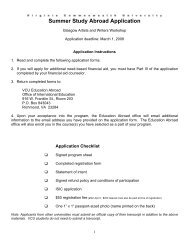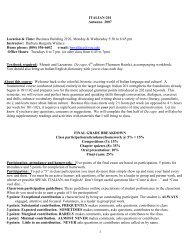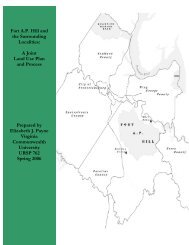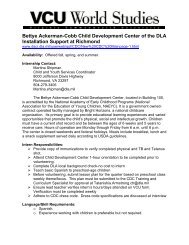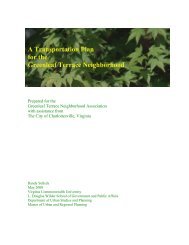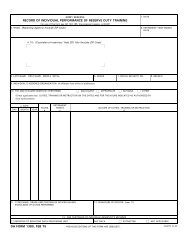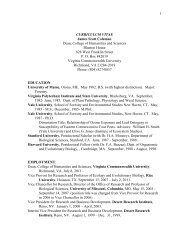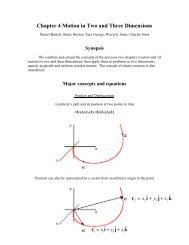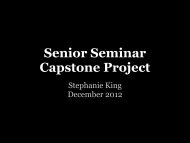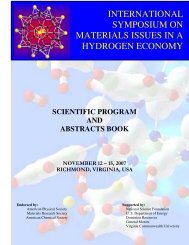Focus on Forensics - College of Humanities and Sciences - Virginia ...
Focus on Forensics - College of Humanities and Sciences - Virginia ...
Focus on Forensics - College of Humanities and Sciences - Virginia ...
You also want an ePaper? Increase the reach of your titles
YUMPU automatically turns print PDFs into web optimized ePapers that Google loves.
<str<strong>on</strong>g>Focus</str<strong>on</strong>g> <strong>on</strong> <strong>Forensics</strong><br />
Volume 11, Issue 2<br />
Spring<br />
Faculty<br />
Tracey Daws<strong>on</strong> Cruz<br />
In the Community<br />
Lyndsay Durham<br />
Chris Ehrhardt<br />
Eric Hazelrigg<br />
Marilyn Miller<br />
Michelle Peace<br />
Sarah Seashols<br />
Affiliate:<br />
B<strong>on</strong>nie Brown<br />
Ann Davis<br />
Eileen Davis<br />
Susan Greenspo<strong>on</strong><br />
Pete Mar<strong>on</strong>e<br />
Al Poklis<br />
Robert Steiner<br />
Kevin Whaley<br />
Carl Wolf<br />
COMMUNITY 1<br />
GRADUATION 2<br />
SPOTLIGHT<br />
Inside this issue:<br />
CHAIR’S CORNER 3<br />
GRADUATE 3<br />
On October 19, the VCU Forensic Science department, al<strong>on</strong>g with the Library <strong>of</strong> <strong>Virginia</strong> hosted<br />
award-winning mystery writer Marcia Talley <strong>and</strong> the CSI for Young Mystery Writers Workshop. As<br />
part <strong>of</strong> the <strong>Virginia</strong> Literary Festival, the event was attended by 20 middle school students from<br />
throughout the greater Richm<strong>on</strong>d area <strong>and</strong> was very successful! These young students were able<br />
to tackle forensic investigati<strong>on</strong>s h<strong>and</strong>s <strong>on</strong> <strong>and</strong> then learn the steps to turning these experiences<br />
into a mystery novel. Activities, created by the Forensic Science faculty <strong>and</strong> lead by current VCU<br />
forensic science students, ranged from drawing a crime scene to analyzing their own fingerprints<br />
<strong>and</strong> viewing paint samples under a microscope. The budding scientists were very excited to be<br />
using the same laboratories <strong>and</strong> equipment that their student mentors use <strong>on</strong> a daily basis. The<br />
evening c<strong>on</strong>cluded with Ms. Talley leading the students in writing exercises based <strong>on</strong> the science<br />
activities they completed. Events such as this <strong>on</strong>e are critical to inspiring future generati<strong>on</strong>s <strong>of</strong><br />
forensic scientists <strong>and</strong> the department hopes to make this an annual event. In a few short years,<br />
perhaps some <strong>of</strong> the participants will be back <strong>on</strong> campus as forensic science students!<br />
UNDERGRAD 4<br />
INTERNATIONAL 5<br />
MILITARY 6<br />
SPORT 6<br />
ALUMNI 7<br />
FERRARA SCHOLARSHIP 8<br />
FSSC 8<br />
NEW FACULTY 9<br />
AAFS PRESENTATIONS<br />
COLLABORATION<br />
10<br />
11<br />
UPCOMING EVENTS 11<br />
GRAD OPEN HOUSE<br />
DART<br />
ADJUNCT FACULTY<br />
INTRAMURALS<br />
12<br />
12<br />
13-14<br />
15
Page 2 F ocus <strong>on</strong> Fo rensics Volume 11, Issue 2<br />
Undergraduate Class <strong>of</strong> December, 2012<br />
Graduates<br />
Cammie Alst<strong>on</strong><br />
Carla Bacchus<br />
Tiffany Collins<br />
Alexis Cousins<br />
Sean Cr<strong>on</strong>in<br />
Rh<strong>on</strong>da Daniel<br />
M. Grace Diam<strong>on</strong>d<br />
Cathy Eyi-Mensah<br />
Aerial Ferebee<br />
Antoinette Fox<br />
Sabih Haq<br />
Jasmine Harge<br />
T. Grier Harlow<br />
Saad Khan<br />
Justin Lee<br />
Ishaq Mallik<br />
John Marshall<br />
Mia Maynard<br />
Pamela Parker<br />
Tiffany Rolle<br />
Hinna Shakh<br />
Jessica Smith<br />
Ashley Spence<br />
Megan Tabor<br />
Shana Terry<br />
Teri White<br />
Kristen Whited<br />
Outst<strong>and</strong>ing Undergraduate<br />
Megan Tabor<br />
Leadership & Service<br />
Cammie Alst<strong>on</strong><br />
Tiffany Collins<br />
Alexis Cousins<br />
Antoinette Fox<br />
Megan Tabor
Volume 11, Issue 2<br />
F ocus <strong>on</strong> Fo rensics<br />
Page 3<br />
Chair’s Corner Michelle Peace<br />
Greetings Alumni, Friends, <strong>and</strong> Students!<br />
VCU is truly an astounding place – <strong>and</strong>, as you will see in this newsletter,<br />
this Department is full <strong>of</strong> energy, creativity, <strong>and</strong> excellence! We truly<br />
have a difficult time deciding what stories should be featured here as<br />
every day something exciting is happening to some<strong>on</strong>e <strong>and</strong> great advancements<br />
are made. So, if you are curious as to other news in the<br />
Dr. Peace<br />
with students<br />
at AAFS 2013<br />
Department, then I encourage you to “like” us Facebook (VCU Forensic Science) <strong>and</strong><br />
visit our blog (FRSC Blog).<br />
What I hope you take away from this editi<strong>on</strong> is that no matter how you are affiliated with this Department <strong>and</strong> this University, opportunities<br />
are plentiful for you to engage. If you think you have an opportunity or want to take advantage <strong>of</strong> something we already<br />
have going, I invite you to c<strong>on</strong>tact us! If you have a story that you think we would like to feature, then please let us know!<br />
We’re always combing the archives for potential stories about “what happened to?” <strong>and</strong> “look what this pers<strong>on</strong> is doing!”<br />
Thanks for reading! Thanks for stopping by the Department when you’re in town! Thanks for mentoring our students! Thanks for<br />
supporting our scholarship funds that support student achievements! And, thanks for being a part <strong>of</strong> VCU’s Department <strong>of</strong> Forensic<br />
Science! GO RAMS!!<br />
Graduate Spotlight Hope Parker, Lauren Phillips, Teresa Sikes<br />
The Nati<strong>on</strong>al Institute <strong>of</strong> Justice in partnership with the<br />
Forensic Science Foundati<strong>on</strong> <strong>of</strong>fers research grants each year<br />
to students enrolled in FEPAC accredited Forensic Science Programs.<br />
This past Fall, three <strong>of</strong> these grants were awarded to<br />
sec<strong>on</strong>d year graduate students in the Forensic Science Department<br />
at VCU: Hope Parker, Lauren Phillips <strong>and</strong> Teresa<br />
Sikes. Each <strong>of</strong> the students received the maximum amount<br />
designated by the grant, bringing a total <strong>of</strong> $21,000 into the department<br />
to fund their research. Hope Parker is working in the<br />
Daws<strong>on</strong> Cruz research laboratory. Her project is focused<br />
around incorporating mixture detecti<strong>on</strong> into a qPCR multiplex by<br />
using Scorpi<strong>on</strong> primers <strong>and</strong> tri-allelic SNPs. She presented at<br />
the AAFS C<strong>on</strong>ference in February <strong>and</strong> the Internati<strong>on</strong>al Symposium<br />
<strong>on</strong> Microscale Bioseparati<strong>on</strong>s in March, <strong>and</strong> plans to present<br />
at MAAFS in May. Lauren Phillips is working in the<br />
Ehrhardt research lab <strong>on</strong> a project that is analyzing the surfaces<br />
<strong>of</strong> pollen grains from Cornus florida for the presence <strong>of</strong> volatile<br />
organic compounds <strong>and</strong> trace metals for the identificati<strong>on</strong> <strong>of</strong> forensic<br />
signatures. She presented at both the 21st Annual Onsite/Ifpac<br />
C<strong>on</strong>ference in January as well as the 65th Annual<br />
YFSF AAFS C<strong>on</strong>ference in February. Teresa Sikes is also working<br />
in the Daws<strong>on</strong> Cruz research lab in collaborati<strong>on</strong> with the<br />
L<strong>and</strong>ers Bioanalytical Microchip Laboratory at the University <strong>of</strong><br />
<strong>Virginia</strong>. Her project aims to develop a simplified, integrated<br />
DNA extracti<strong>on</strong> <strong>and</strong> amplificati<strong>on</strong> microdevice <strong>on</strong> a centrifugal<br />
platform with infrared-mediated heating <strong>and</strong> to test this device<br />
with challenge mock-casework samples. She presented at the<br />
AAFS C<strong>on</strong>ference in February plans to present at MAAFS in<br />
May.
Volume 11, Issue 2<br />
F ocus <strong>on</strong> Fo rensics<br />
Page 4<br />
Undergraduate Spotlight: Aryn McClain<br />
I am a third-year Forensic Science student at VCU <strong>and</strong> am Secretary <strong>of</strong> the Forensic Science Student<br />
Club. I chose to study Forensic Science because it is an ever-changing discipline—there is always room for improving<br />
techniques <strong>and</strong> discovering new <strong>on</strong>es. Forensic science is also extremely fascinating! Just think, it is nearly impossible<br />
to go anywhere without leaving a trace for a forensic scientist to uncover. I love all kinds <strong>of</strong> puzzles <strong>and</strong><br />
piecing together a crime is like solving <strong>on</strong>e giant puzzle! I’ve wanted to be a forensic pathologist since I was 12<br />
years old. A medical examiner acts as the victim’s voice <strong>and</strong> can help<br />
bring peace to the deceased’s family. It will be so fulfilling to piece a<br />
crime together from the victim’s st<strong>and</strong>point in order to help guide investigators<br />
in the right directi<strong>on</strong> to “catch the bad guy.” I am well-aware <strong>of</strong><br />
the l<strong>on</strong>g years <strong>of</strong> school ahead <strong>of</strong> me, but I am so eager to begin my<br />
journey! I have been lucky enough to observe autopsies at the Office <strong>of</strong><br />
the Chief Medical Examiner in Richm<strong>on</strong>d <strong>and</strong> have shadowed a clinical<br />
pathologist at MCV for the last several m<strong>on</strong>ths. Both <strong>of</strong> these experiences<br />
have boosted my passi<strong>on</strong> for pathology even more.<br />
I work part-time as a hostess at The Jeffers<strong>on</strong> Hotel <strong>and</strong> as an afterschool<br />
nanny to save m<strong>on</strong>ey for medical school <strong>and</strong> in my free time I<br />
volunteer at a hospital. But, my favorite hat to wear is my Peppa hat. I<br />
am a Peppa in VCU’s famous pep b<strong>and</strong>, The Peppas. I’ve played the<br />
tromb<strong>on</strong>e for 10 years <strong>and</strong> I have loved every minute <strong>of</strong> it. Being part <strong>of</strong><br />
The Peppas has been a blast.<br />
Since I am <strong>on</strong> a b<strong>and</strong> scholarship, I have been lucky enough to<br />
travel all over the United States following the successes <strong>of</strong> both the<br />
men’s <strong>and</strong> women’s basketball teams. In the 2010-2011 seas<strong>on</strong>, The<br />
Peppas pepped Shaka Smart <strong>and</strong> his gang through victories in Dayt<strong>on</strong>, OH, Chicago, IL, San Ant<strong>on</strong>io, TX <strong>and</strong> all<br />
the way to the Final Four in Houst<strong>on</strong>, TX. We were even deemed Best Pep B<strong>and</strong> in America when we w<strong>on</strong> ESPN’s<br />
Battle <strong>of</strong> the Final Four B<strong>and</strong>s.<br />
In the 2011-2012 seas<strong>on</strong>, other sports teams requested The Peppas’ presence at their events. We were<br />
able to travel to the women’s CAA basketball tournament in Maryl<strong>and</strong> to pep our Lady Rams through two victories.<br />
We also followed Shaka <strong>and</strong> the guys across the country to Portl<strong>and</strong>, OR for their most recent dance in March Madness.<br />
In this 2012-2013 seas<strong>on</strong>, The Peppas are back like never before. We were c<strong>on</strong>tracted to play at all men’s<br />
<strong>and</strong> women’s soccer games, field hockey games, <strong>and</strong> volleyball matches this Fall <strong>and</strong> all women’s <strong>and</strong> men’s basketball<br />
games this Spring. Whew! It certainly sounds exhausting all laid out like this, but our awesome director,<br />
Ryan Kopacsi, keeps the energy up with his crazy moves. He is so passi<strong>on</strong>ate about music <strong>and</strong> VCU sports, so<br />
when you combine the two with Ryan’s <strong>and</strong> The Peppas’ energy, you get the Peppa Effect. Last year, we even recorded<br />
a CD <strong>of</strong> our madness!<br />
The Peppas are the backb<strong>on</strong>e <strong>of</strong> the havoc that wreaks<br />
throughout the Siegel Center <strong>on</strong> game days. We pump up the team<br />
<strong>and</strong> the crowd with our “You D<strong>on</strong>’t Wanna Go To War” s<strong>on</strong>g, <strong>and</strong> we<br />
do a great job heckling the opposing teams. The Peppas play all kinds<br />
<strong>of</strong> music. During January, we invite any middle school <strong>and</strong> high school<br />
instrumentalists to spend a day with us <strong>and</strong> play music at <strong>on</strong>e <strong>of</strong> the<br />
men’s basketball games. This b<strong>and</strong> is so much fun to be a part <strong>of</strong> because<br />
<strong>of</strong> all the diversity. We are not affiliated with VCU’s School <strong>of</strong><br />
Music <strong>and</strong> any<strong>on</strong>e can auditi<strong>on</strong> for a spot in the b<strong>and</strong>. The Peppas are<br />
a bunch <strong>of</strong> engineering geniuses, science whizzes, art kids, music<br />
students, <strong>and</strong> history buffs who love playing great music <strong>and</strong> cheering<br />
<strong>on</strong> VCU’s sports teams. You can check out The Peppas at the Battle<br />
<strong>of</strong> the Final Four B<strong>and</strong>s <strong>and</strong> other places around the country here . Go<br />
Rams!
Volume 11, Issue 2<br />
F ocus <strong>on</strong> Fo rensics<br />
Page 5<br />
Internati<strong>on</strong>al Spotlight Kim Perusse, MS ‘05<br />
As I sit here in the middle <strong>of</strong> Afghanistan, I <strong>of</strong>ten ask myself how<br />
I did I get to this point! Never in my wildest dreams, even as a<br />
forensic science graduate student at VCU, did I say “Yeah I want<br />
to go to Afghanistan”. But here I am in a giant s<strong>and</strong>box doing<br />
battlefield forensic science.<br />
While completing my master’s at VCU, my goal was to work for<br />
the Drug Enforcement Administrati<strong>on</strong> (DEA) as a Forensic Drug<br />
Chemist. That goal was realized by the time I got my degree <strong>and</strong><br />
within six m<strong>on</strong>ths I was employed in my dream job at the DEA<br />
San Francisco Western Laboratory. I loved that job <strong>and</strong> could<br />
see myself there through retirement.<br />
After being with DEA for about 6 years <strong>and</strong> a promoti<strong>on</strong> to Senior<br />
Forensic Chemist under my belt, I was set. I just had to keep my<br />
head down <strong>and</strong> look toward retirement… in 25 years! Did I really<br />
want to spend 25 years testing bags <strong>of</strong> methamphetamine?<br />
Sure I could <strong>and</strong> I would be happy doing it, it was my dream job<br />
after all.<br />
Then, a former coworker put a little bug in my ear. She had<br />
moved <strong>on</strong> to the United States Army Criminal Investigati<strong>on</strong> Laboratory,<br />
Expediti<strong>on</strong>ary Forensic Divisi<strong>on</strong> (USACIL, EFD) as a<br />
latent print examiner. She had just returned from her first rotati<strong>on</strong><br />
in Afghanistan <strong>and</strong> was ready to go back. When I was talking<br />
to her she menti<strong>on</strong>ed they were looking for chemists <strong>and</strong> I<br />
should check it out. I shrugged it <strong>of</strong>f c<strong>on</strong>tending that I already<br />
had my dream job, why would I want to risk that by leaving? A<br />
few m<strong>on</strong>ths <strong>and</strong> life changes later <strong>and</strong> my resistance started to<br />
change, thinking instead <strong>of</strong> it as a <strong>on</strong>ce in a lifetime opportunity.<br />
I am still young <strong>and</strong> without a house, kids, husb<strong>and</strong>, etc. now is<br />
the time to do it, it’s now<br />
or never.<br />
A big fear <strong>of</strong> committing<br />
to the job was what<br />
comes after this? The job<br />
market isn’t very stable.<br />
What if I d<strong>on</strong>’t like it?<br />
Once they pull out <strong>of</strong> Afghanistan,<br />
will I still have<br />
a job? I eventually had to<br />
tell myself that I have to<br />
live in the now. I had to<br />
trust that my knowledge<br />
<strong>and</strong> experience from<br />
VCU, DEA, <strong>and</strong> USACIL,<br />
EFD would make me<br />
marketable.<br />
So I took the plunge, within 3 m<strong>on</strong>ths I was moved to Atlanta<br />
starting my next chapter. My current primary duties are to examine<br />
improvised explosive devices (IEDs).<br />
After training I was sent into Afghanistan. So far so good. Lots<br />
<strong>of</strong> dust, everywhere <strong>and</strong> in places it should never be. There are<br />
some creature comforts, such as KFC <strong>and</strong> TGI Friday, but the<br />
Afghan culture is all around, especially in the bazaar <strong>and</strong> other<br />
local shops.<br />
One <strong>of</strong> the biggest impacts <strong>of</strong> arriving here is that it really hits<br />
home why I am here <strong>and</strong> why there is battlefield forensics in the<br />
first place. It is the soldiers who put their life <strong>on</strong> the line every<br />
time they step <strong>of</strong>f the base. The analysis we do in all secti<strong>on</strong>s <strong>of</strong><br />
the lab may give them the needed informati<strong>on</strong> to save lives <strong>and</strong><br />
stop it from happening again.<br />
I d<strong>on</strong>’t know what lies in my future, perhaps I will return to my<br />
“dream” job at DEA, but in the now I know that I am where I<br />
should be.
Volume 11, Issue 2<br />
F ocus <strong>on</strong> Fo rensics<br />
Page 6<br />
Military Spotlight<br />
Derek M<strong>on</strong>thei , BIS ‘01<br />
I graduated from<br />
VCU in 2004 with a<br />
BS in Forensic Science.<br />
During this<br />
time I was also the<br />
Treasurer <strong>of</strong> the Forensic<br />
Science Student<br />
Club. My senior<br />
year I knew that I<br />
wanted to specialize<br />
in entomology. I<br />
completed my doctorial research at <strong>Virginia</strong> Tech in<br />
2009 where I c<strong>on</strong>ducted research involving thermal factors<br />
as well as toxicological factors affecting the development<br />
<strong>of</strong> blowflies.<br />
I was commissi<strong>on</strong>ed as an Officer in the US Army in<br />
April 2009 <strong>and</strong> spent 19 m<strong>on</strong>ths at Fort Lewis,<br />
WA. working for Public Health Comm<strong>and</strong>-West, which<br />
helped train Soldiers in various things such as preventi<strong>on</strong><br />
<strong>of</strong> arthropod-borne disease <strong>and</strong> proper storage <strong>of</strong><br />
pesticides. I also helped manage the disease testing<br />
Polymerase Chain Reacti<strong>on</strong> (PCR) lab during that<br />
time. I later served as the Executive Officer for a Preventive<br />
Medicine Detachment. The Executive Officer<br />
job was primarily an administrative job where I managed<br />
the rolling stock, supplies, <strong>and</strong> managed the day<br />
to day operati<strong>on</strong>s for the Comm<strong>and</strong>er. I am currently<br />
located at Fort Bragg, NC where I serve as the hospital<br />
entomologist. My primary job is mosquito <strong>and</strong> tick surveillance<br />
for the installati<strong>on</strong> where I try <strong>and</strong> prevent the<br />
residents <strong>and</strong> Soldiers <strong>of</strong> Fort Bragg from c<strong>on</strong>tracting<br />
an arthropod-borne disease like West Nile virus.<br />
While I do not have the typical forensic scientist career,<br />
I have used many <strong>of</strong> the skill sets I learned from the<br />
VCU Forensic Science Program since I have started<br />
with the military. I document informati<strong>on</strong>, maintain<br />
chain <strong>of</strong> custody, <strong>and</strong> write reports. The str<strong>on</strong>g science<br />
background in general provided me with lots <strong>of</strong> useful<br />
tools in my military career. When I was managing the<br />
PCR lab some <strong>of</strong> the employees were impressed with<br />
my pipetting techniques <strong>and</strong> my knowledge <strong>of</strong> molecular<br />
biology. This knowledge was primarily gained from<br />
my Forensic Molecular Biology class I took when I was<br />
at VCU. I am not a molecular biologist by any stretch <strong>of</strong><br />
the imaginati<strong>on</strong>, but I retained enough informati<strong>on</strong> from<br />
the class to manage the laboratory effectively. I did not<br />
end up in a forensic lab, but the skills <strong>and</strong> diverse science<br />
courses I took at VCU provided me the tools to be<br />
successful in my military career.<br />
Sport Spotlight<br />
Heather Shacker, MS ‘10<br />
When I first moved to Richm<strong>on</strong>d from Edm<strong>on</strong>t<strong>on</strong>,<br />
Canada for graduate school I had <strong>on</strong>ly been fencing<br />
for a year. I joined a club at my undergraduate university<br />
<strong>on</strong> a whim <strong>on</strong>e summer <strong>and</strong> was immediately<br />
hooked. I have never really c<strong>on</strong>sidered myself athletic<br />
(in fact I still sometimes trip over my own feet!) but I<br />
love both the physical <strong>and</strong> mental challenges <strong>of</strong> fencing.<br />
I c<strong>on</strong>tinued fencing at a local club while working<br />
<strong>on</strong> my Master's degree at VCU which gave me a<br />
chance to meet a w<strong>on</strong>derful group <strong>of</strong> people outside<br />
<strong>of</strong> my friends at school. I loved having a "fencing family"<br />
when my own was an entire c<strong>on</strong>tinent away!<br />
Travelling for tournaments was a great way for me as<br />
a Canadian to see more <strong>of</strong> <strong>Virginia</strong> <strong>and</strong> some <strong>of</strong> the<br />
other east coast states as well. But really, the best<br />
thing about fencing while at VCU was that it gave me<br />
an outlet to de-stress after attending classes or serving<br />
as a TA. Having something to take my mind <strong>of</strong>f<br />
school for a few hours helped me to be that much<br />
more focused the rest <strong>of</strong> the day.<br />
Fast forward almost three years after graduati<strong>on</strong> <strong>and</strong><br />
I'm now working at the Centre <strong>of</strong> Forensic <strong>Sciences</strong> in<br />
Tor<strong>on</strong>to, Canada as a forensic scientist in the biology<br />
secti<strong>on</strong>. I'm also still fencing, training four days a<br />
week <strong>and</strong> attending competiti<strong>on</strong>s many weekends.<br />
I've met some amazing people this way <strong>and</strong> had the<br />
opportunity to visit places all over the world for both<br />
nati<strong>on</strong>al <strong>and</strong> internati<strong>on</strong>al competiti<strong>on</strong>s. Fencing has<br />
shown me that hard work <strong>and</strong> dedicati<strong>on</strong> are needed<br />
in order to succeed. Being able to apply this to my<br />
every day life was a huge factor in making it through<br />
the interview process <strong>and</strong> training program <strong>of</strong> my current<br />
job <strong>and</strong> I know that my ability to work hard will<br />
c<strong>on</strong>tinue to help me in my career as a forensic scientist.
Page 7 F ocus <strong>on</strong> Fo rensics Volume 11, Issue 2<br />
Alumni Spotlight AAFS Nati<strong>on</strong>al C<strong>on</strong>ference<br />
Once again, the VCU Department <strong>of</strong> Forensic Science hosted a<br />
recepti<strong>on</strong> at the American Academy <strong>of</strong> Forensic Science Annual<br />
Meeting. This year the meeting was held in Washingt<strong>on</strong> so we had<br />
a w<strong>on</strong>derful crowd <strong>of</strong> students, alumni <strong>and</strong> friends <strong>of</strong> the department join us as we celebrated<br />
<strong>and</strong> networked.<br />
Over 100 students, alumni, faculty <strong>and</strong> friends <strong>of</strong> the department visited us to enjoy<br />
the ice cream bar <strong>and</strong> participate in activities to help us learn how VCU Makes It Real.<br />
“VCU got me my dream job” (alumni), ”I am absolutely impressed with the Forensic<br />
Science Program <strong>and</strong> take great pleasure in telling others the VCU story” (friend), <strong>and</strong><br />
“By following my dreams <strong>and</strong> aspiring to be a better scientist at the end <strong>of</strong> the day” (student)<br />
were comments received by our guests when asked to write how VCU Makes It Real for<br />
them. These resp<strong>on</strong>ses were entered in a raffle where winners received VCU t-shirts, caps, c<strong>of</strong>fee<br />
mugs <strong>and</strong> Rodney the Ram paraphernalia. In additi<strong>on</strong>, guests had a chance to tell us what<br />
they loved about VCU. Stay tuned to our website for a video featuring these participants. We<br />
thank you all for your attendance <strong>and</strong> support <strong>of</strong> the Department <strong>of</strong> Forensic Science.
Volume 11, Issue 2<br />
F ocus <strong>on</strong> Fo rensics<br />
Page 8<br />
Dr. Paul B. Ferrara Scholarship in Forensic Science<br />
Jessica Haithcock, Recipient<br />
The Department <strong>of</strong> Forensic Science awarded the inaugural Dr. Paul<br />
B. Ferrara Scholarship <strong>on</strong> October 16, 2012 to Jessica Haithcock, a<br />
sec<strong>on</strong>d year graduate student. The scholarship was established by<br />
Dr Ferrara’s family <strong>and</strong> the <strong>College</strong> <strong>of</strong> <strong>Humanities</strong> <strong>and</strong> <strong>Sciences</strong> to<br />
c<strong>on</strong>tinue Dr. Ferrara’s legacy in the field <strong>of</strong> forensic science. Dr. Ferrara<br />
served as the director <strong>of</strong> the <strong>Virginia</strong> Department <strong>of</strong> Forensic<br />
Science <strong>and</strong> dedicated 33 years to improving public safety, most<br />
notably by pi<strong>on</strong>eering the use <strong>of</strong> DNA technology. In 1989 <strong>and</strong> under<br />
his leadership, the Comm<strong>on</strong>wealth <strong>of</strong> <strong>Virginia</strong> became the first state<br />
laboratory capable <strong>of</strong> performing DNA fingerprinting analyses. In<br />
additi<strong>on</strong> to his directorship <strong>of</strong> VA-DFS, Dr. Ferrara was a pr<strong>of</strong>essor<br />
at <strong>Virginia</strong> Comm<strong>on</strong>wealth University. Through his passi<strong>on</strong> for teaching<br />
<strong>and</strong> research, as well as his commitment to developing a nati<strong>on</strong>ally<br />
recognized Forensic Science educati<strong>on</strong>al program at VCU, the<br />
program <strong>of</strong>ficially became a department in 2005. The VCU Department<br />
<strong>of</strong> Forensic Science c<strong>on</strong>tinues to work closely with the VA-DFS<br />
to educate <strong>and</strong> train students <strong>and</strong> pr<strong>of</strong>essi<strong>on</strong>als as well as to perform<br />
research in the various forensic science disciplines. The VCU<br />
faculty <strong>and</strong> VA-DFS staff remain committed to cutting edge, h<strong>and</strong>s<strong>on</strong><br />
educati<strong>on</strong> <strong>and</strong> are leaders in relevant, scientifically rigorous research.<br />
Jessica was awarded the Dr. Paul B. Ferrara Scholarship for her<br />
directed research utilizing Atomic Force Microscopy (AFM) for<br />
the identificati<strong>on</strong> <strong>of</strong> forensic signatures indicative <strong>of</strong> culturing<br />
c<strong>on</strong>diti<strong>on</strong>s <strong>and</strong> preparati<strong>on</strong>. The Amerithrax investigati<strong>on</strong> in 2001<br />
highlighted the need for forensic signatures that can rapidly identify a<br />
threat agent <strong>and</strong> determine the laboratory in which it was cultured.<br />
Since then, many methods have been developed to identify the species<br />
or strain <strong>of</strong> organisms in evidence recovered from a biocrime.<br />
However, few forensic signatures exist that indicate the culturing<br />
c<strong>on</strong>diti<strong>on</strong>s <strong>of</strong> a threat agent <strong>and</strong>, therefore, the lab <strong>of</strong> origin. One<br />
promising strategy for addressing this need is analyzing an organism’s<br />
cell surface hydrophobicity. Jessica’s research will investigate<br />
cell surface hydrophobicity<br />
with AFM<br />
using chemically<br />
modified tips. Specifically,<br />
the goal <strong>of</strong> this<br />
project is to characterize<br />
the cell surface<br />
<strong>of</strong> different Bacillus<br />
spp. spores grown in<br />
various culturing c<strong>on</strong>diti<strong>on</strong>s.<br />
Since AFM<br />
can detect minute<br />
interactive forces <strong>and</strong><br />
Dale & T<strong>on</strong>y Ferrara with Dr. Paul B Ferrara Scholarship<br />
recipient, Jessica Haithcock<br />
illustrate nanoscale surface detail, it is great tool for single-cell analysis.<br />
The use <strong>of</strong> AFM in identifying cell surface hydrophobic differences<br />
<strong>of</strong> Bacillus spores batch cultured in various growth c<strong>on</strong>diti<strong>on</strong>s<br />
may ultimately help law enforcement agencies investigate acts <strong>of</strong><br />
bioterrorism or other biocrimes.<br />
Forensic Science Student Club Adventurous Ventures<br />
The VCU Forensic Science Student Club has been busier than ever this semester! With new events like the MCV Blood Bank Tour <strong>and</strong> classic<br />
favorites like the Domini<strong>on</strong> Shooting Range comprising the calendar <strong>of</strong> events, the club has had a lot to look forward to <strong>and</strong> has no plans<br />
to slow down!<br />
The semester started out with a bang as club members headed down to the biannual stomping<br />
ground, Domini<strong>on</strong> Shooting Range. Students tested firearms <strong>of</strong> various calibers <strong>and</strong><br />
learned proper safety protocols. Whether it is a student’s first time or fiftieth, this event is always<br />
a hit!<br />
A new event made its first appearance <strong>on</strong> the Club roster this spring. The club <strong>of</strong>fered students<br />
a chance to take a trip to the MCV Blood Bank to find out what happens after they<br />
make those campus d<strong>on</strong>ati<strong>on</strong>s. Many were pleased to find that the process goes well bey<strong>on</strong>d<br />
blood typing <strong>and</strong> separati<strong>on</strong>. With such positive feedback, this may become a new club traditi<strong>on</strong>!<br />
A lucky few visited the medical campus for an in depth tour <strong>of</strong> the Medical Examiner’s <strong>of</strong>fice <strong>on</strong> March 26th. The list to attend filled up fast,<br />
as this event was highly anticipated.<br />
One <strong>of</strong> the club’s biggest events <strong>of</strong> the spring is almost here! The entire VCU Forensic community<br />
is invited to attend Harold Logan’s Fundraiser for the Hawaiian Associati<strong>on</strong> <strong>of</strong> Authentic Leis, (aka<br />
Murder Mystery 2013, featuring a tropical twist!) Bring the entire family out for a night to remember<br />
<strong>on</strong> Sunday, April 14 th at 5:30 pm in The <strong>Virginia</strong><br />
Ballrooms <strong>of</strong> the VCU Student Comm<strong>on</strong>s. Isl<strong>and</strong> attire<br />
is encouraged! Tickets are $10 <strong>and</strong> can be purchased<br />
at the VCU Breakpoint fr<strong>on</strong>t desk, beginning Wednesday,<br />
March 27 th . Seating is limited, so be sure to get yours while you can!<br />
A final celebrati<strong>on</strong> closed out the semester’s events, as the seas<strong>on</strong> winds down. A Forensic<br />
Science Student Club pot luck was held <strong>on</strong> Saturday, March 23 rd .
Volume 11, Issue 2<br />
F ocus <strong>on</strong> Fo rensics<br />
Page 9<br />
New Faculty<br />
Lyndsay Durham, M.Ed.<br />
Botetourt – or you can just say Roanoke; whatever is easier for you. Ms. Durham comes to the<br />
VCU Department <strong>of</strong> Forensic Science from a county in southwest <strong>Virginia</strong> at the foothills <strong>of</strong> the<br />
Blue Ridge Mountains where things are slower paced <strong>and</strong> a little more relaxed. The move from<br />
the country to the “big city” <strong>of</strong> Richm<strong>on</strong>d was just the change <strong>of</strong> pace she needed to match her<br />
enthusiasm for educati<strong>on</strong>. Ms. Durham received both her undergraduate (a B.S. in Forensic Science!)<br />
<strong>and</strong> graduate (M.Ed. in Curriculum <strong>and</strong> Instructi<strong>on</strong>) degrees from <strong>Virginia</strong> Comm<strong>on</strong>wealth<br />
University. Prior to accepting her positi<strong>on</strong> at VCU, Ms. Durham worked in the Breath Alcohol Secti<strong>on</strong><br />
at the <strong>Virginia</strong> Department <strong>of</strong> Forensic Science. Forensic Science c<strong>on</strong>tinues to be an area <strong>of</strong> interest for Ms.<br />
Durham as she investigates new <strong>and</strong> emerging forensic technologies in her role as Grant Facilitator for the Forensic<br />
Technology Center <strong>of</strong> Excellence here at VCU. You may have also seen Ms. Durham around campus since she teaches<br />
the FRSC 202 Crime <strong>and</strong> Science general educati<strong>on</strong> course for Undergraduate n<strong>on</strong>-majors <strong>and</strong> serves as an advisor for<br />
some <strong>of</strong> you guys here in the Department!<br />
B<strong>on</strong>nie Brown, PhD<br />
Dr. B<strong>on</strong>nie Brown was approved as an affiliate faculty appointment <strong>of</strong> the Department <strong>of</strong> Forensic Science. Dr. Brown is<br />
a Pr<strong>of</strong>essor in the Department <strong>of</strong> Biology where she also serves as the Associate Chair. Dr. Brown received a BS in<br />
Biology from the University <strong>of</strong> Alabama <strong>and</strong> a PhD in Oceanography from Old Domini<strong>on</strong> University. After a brief post-doc<br />
at Johns Hopkins University, she was hired by VCU as an Assistant Research Pr<strong>of</strong>essor <strong>and</strong> was eventually promoted to<br />
full Pr<strong>of</strong>essor. While Dr. Brown is an evoluti<strong>on</strong>ary geneticist who primarily studies marine species, her unique multidisciplinary<br />
background <strong>of</strong>fers opportunities across a variety <strong>of</strong> disciplines. She is well known for her collaborative spirit<br />
which is reflected by her appointments <strong>and</strong> work outside <strong>of</strong> the Biology Department. In additi<strong>on</strong> to teaching resp<strong>on</strong>sibilities<br />
<strong>and</strong> a heavy service load over her 22 year VCU career, Dr. Brown has been able to establish a very successful research<br />
laboratory. In the past five years, her laboratory group has published more than 14 peer-reviewed manuscripts<br />
<strong>and</strong> has obtained $500K in external competitive grant funds. Dr. Brown has also served the Department<br />
<strong>of</strong> Forensic Science in numerous ways including research collaborati<strong>on</strong> with forensic<br />
science faculty, external/third committee member for graduate student directed research committees,<br />
research mentor/PI for forensic science undergraduate students, Chair <strong>and</strong> member <strong>of</strong> the<br />
Daws<strong>on</strong> Cruz promoti<strong>on</strong> <strong>and</strong> tenure committee <strong>and</strong> developer <strong>and</strong> co-instructor <strong>of</strong> FRSC 591<br />
Populati<strong>on</strong> Genetics for Forensic Scientists. For these c<strong>on</strong>tributi<strong>on</strong>s as well as informal interacti<strong>on</strong><br />
with the department, we welcome Dr. Brown to our faculty.
Page 10 F ocus <strong>on</strong> Fo rensics Volume 11, Issue 2<br />
AAFS Nati<strong>on</strong>al C<strong>on</strong>ference Presentati<strong>on</strong>s<br />
The Department <strong>of</strong> Forensic Science is excited that we had a tremendous c<strong>on</strong>tingent <strong>of</strong> 46 students <strong>and</strong> all <strong>of</strong> the faculty<br />
from our Graduate <strong>and</strong> Undergraduate Programs attend the Annual Meeting <strong>of</strong> the American Academy <strong>of</strong> Forensic Science,<br />
(AAFS). C<strong>on</strong>gratulati<strong>on</strong>s to the 20 students, alumni <strong>and</strong> faculty <strong>of</strong> the VCU Department <strong>of</strong> Forensic Science who presented<br />
at the c<strong>on</strong>ference.<br />
Lucy Camarena: Optimized Centrifugal Methods for Separati<strong>on</strong> <strong>of</strong><br />
Semen From Superabsorbent Polymers for Forensic Analysis<br />
Shann<strong>on</strong> Cassatt: Identificati<strong>on</strong> <strong>and</strong> Quantificati<strong>on</strong> <strong>of</strong> Tapentadol <strong>and</strong><br />
N-DesmethyItapentadol in Human Urine Using Gas Chromatography-<br />
Mass Spectrometry<br />
Lee Dean: Forensic Mixture Analysis: Pre-Emptive Separati<strong>on</strong> <strong>of</strong><br />
Whole Cells With Flow Cytometry <strong>and</strong> MHC Class I Allele Tagging<br />
Jacob Easter: Pharmaceutical Identifier C<strong>on</strong>firmati<strong>on</strong> Via AccuTOF<br />
DART<br />
Omar ElJordi: Analysis <strong>and</strong> Characterizati<strong>on</strong> <strong>of</strong> the First <strong>and</strong> Sec<strong>on</strong>d<br />
Generati<strong>on</strong> Raving Drag<strong>on</strong> Novelty Bath Salts<br />
Paige Gardner: Evaluati<strong>on</strong> <strong>of</strong> Lip Cosmetics Using Raman Spectroscopy<br />
Jessica Haithcock <strong>and</strong> Cristina Stanciu: Cell Surface Hydrophobicity<br />
<strong>of</strong> Biothreat Agents: A Novel Forensic Signature for the Attributi<strong>on</strong><br />
<strong>of</strong> Microbial Biocrimes<br />
Kinjalba Jadeja <strong>and</strong> Justin Nguyen: Camera Ph<strong>on</strong>e Photography<br />
<strong>and</strong> AFIS Sufficiency<br />
Jillian Neifield: Development <strong>of</strong> a LC/MS/MS Method for the Detecti<strong>on</strong><br />
<strong>and</strong> Quantitati<strong>on</strong> <strong>of</strong> Zolpidem, Eszopicl<strong>on</strong>e, Ramelte<strong>on</strong>, <strong>and</strong><br />
Zalepl<strong>on</strong> in Blood <strong>and</strong> Urine<br />
Hope Parker: Development <strong>of</strong> Scorpi<strong>on</strong>-Based Multiplex qPCR Assay<br />
for Pre-Screening Mixture Detecti<strong>on</strong><br />
Ciaran Phillip: Forensic Attributi<strong>on</strong> <strong>of</strong> Matchsticks Using Integrated<br />
Analysis With Morphological Examinati<strong>on</strong>, Fourier Transform Infrared<br />
Spectroscopy, Scanning Electr<strong>on</strong> Microscopy-Energy Dispersive X-<br />
Ray Spectroscopy <strong>and</strong> Inductively Coupled Plasma-Mass Spectrometry<br />
Lauren Phillips: Gas Chromatography-Mass Spectrometry <strong>and</strong> Trace<br />
Metal Analysis <strong>of</strong> Pollen Samples: Novel<br />
Kim Samano: Preclinical Investigati<strong>on</strong> <strong>of</strong> CP47, 497: A Widely<br />
Abused Synthetic Cannabinoid<br />
Lisa Schiermeier-Wood: It's the Right Thing to Do- <strong>Virginia</strong>'s Ground<br />
Breaking Post-C<strong>on</strong>victi<strong>on</strong> Program<br />
Sarah Seashols: An Evaluati<strong>on</strong> <strong>of</strong> MicroRNA Stability <strong>and</strong> Internal<br />
St<strong>and</strong>ard Selecti<strong>on</strong> for Forensic Body Fluid Identificati<strong>on</strong><br />
Taylor Shaw: Detecti<strong>on</strong> <strong>and</strong> Dispositi<strong>on</strong> <strong>of</strong> JWH-250, CP47,497, <strong>and</strong><br />
its C8 Homologue in Mice After Inhalati<strong>on</strong> Exposure Using a HPLC/<br />
MS/MS Method<br />
Teresa Sikes: Development <strong>of</strong> an Integrated Microdevice for DNA<br />
Extracti<strong>on</strong> <strong>and</strong> Amplificati<strong>on</strong> <strong>of</strong> Forensic Samples Using Infrared-<br />
Mediated Heating <strong>and</strong> Centrifugal Force<br />
Scott Watanabe: Testing a combined Approach for DNA <strong>and</strong> Trace<br />
Evidence Recovery Using Tape Lifting <strong>on</strong> Forensically Important Substrates
Volume 11, Issue 2<br />
F ocus <strong>on</strong> Fo rensics<br />
Page 11<br />
Department Collaborati<strong>on</strong> Chris Ehrhardt<br />
Over the last year my lab has<br />
built a few research initiatives that<br />
have required us to reach out to<br />
other academic department <strong>on</strong><br />
campus <strong>and</strong> build some exciting<br />
interdisciplinary partnerships.<br />
One example <strong>of</strong> this is the microbial<br />
biosignature initiative. Currently,<br />
we are studying the chemical<br />
properties <strong>of</strong> bacterial surfaces<br />
<strong>and</strong> how they change under<br />
different culturing c<strong>on</strong>diti<strong>on</strong>s. These changes can serve as<br />
forensic signatures for bacterial pathogens produced by a<br />
particular laboratory facility <strong>and</strong> subsequently used in a<br />
biocrime. Over the last 10 years, forensic researchers<br />
have studied these signatures with a variety <strong>of</strong> st<strong>and</strong>ard<br />
microbiological techniques such as spectrophotometry,<br />
gas chromatography pr<strong>of</strong>iling,<br />
<strong>and</strong> fluorescence microscopy.<br />
While my lab is c<strong>on</strong>tinuing to<br />
apply these c<strong>on</strong>venti<strong>on</strong>al methods<br />
to study Bacillus spores<br />
(surrogate for Bacillus anthracis,<br />
the causative agent for anthrax),<br />
we have also begun collaborating<br />
with Dr. Vamsi Yadavalli in<br />
the Chemical <strong>and</strong> Life Science<br />
Engineering Department at<br />
VCU to develop analytical techniques<br />
to study bacterial cells in an entirely new way. Specifically,<br />
we are using Atomic Force Microscopy (AFM) to<br />
pr<strong>of</strong>ile the nanomechanical properties <strong>of</strong> the bacterial cell<br />
membrane <strong>and</strong> explore how these may be used to characterize<br />
pathogens recovered from the scene <strong>of</strong> a biocrime.<br />
Dr. Yadavalli’s expertise in both AFM <strong>and</strong> biophysical interacti<strong>on</strong>s<br />
at the nanoscale has been an invaluable additi<strong>on</strong><br />
to this project that has already generated exciting results<br />
for the forensic community.<br />
tous in the envir<strong>on</strong>ment <strong>and</strong> is<br />
routinely found <strong>on</strong> objects associated<br />
with a crime scene (e.g.<br />
suspect’s clothing, car, weap<strong>on</strong>).<br />
In additi<strong>on</strong>, pollen grains<br />
are <strong>of</strong>ten found <strong>on</strong> improvised<br />
explosive devices <strong>and</strong> used to<br />
investigate terrorism crimes in<br />
foreign countries. The forensic<br />
value <strong>of</strong> pollen lies in the fact<br />
that different plant species have<br />
defined geographic distributi<strong>on</strong>s. Identifying the types <strong>of</strong><br />
pollen associated with a pers<strong>on</strong> or object can help determine<br />
their geographic origin <strong>and</strong>, therefore, help provide<br />
leads during a forensic investigati<strong>on</strong>. Typically, the presence<br />
<strong>of</strong> a pollen species will indicate <strong>on</strong>ly broad geographic<br />
z<strong>on</strong>es (e.g. Southwestern U.S., MidAtlantic U.S.). To<br />
increase the forensic value <strong>of</strong> pollen evidence, we are<br />
looking for new ways to analyze pollen grains that may<br />
provide more specific geographic informati<strong>on</strong> as to its<br />
origin. Specifically, we are analyzing the surface chemistry<br />
<strong>of</strong> pollen <strong>and</strong> identifying compounds that may narrow<br />
down the origin <strong>of</strong> an individual pollen grain to a specific<br />
city or even neighborhood within a city. To accomplish this<br />
task we are teaming up with Dr. Rodney Dyer’s lab in<br />
The Department <strong>of</strong> Biology. Dr. Dyer’s expertise is in<br />
gene flow <strong>and</strong> genetic evoluti<strong>on</strong> <strong>of</strong> pollen grains across<br />
urban l<strong>and</strong>scapes. His lab has helped shape our experimental<br />
designs over the last year as well as our sampling<br />
efforts <strong>of</strong> Dogwood pollen last spring. We have already<br />
used our preliminary data to submit two different funding<br />
proposals to the Nati<strong>on</strong>al Institute <strong>of</strong> Justice <strong>and</strong> the Department<br />
<strong>of</strong> Homel<strong>and</strong> Security.<br />
Another research initiative that has required us to build<br />
interdisciplinary collaborati<strong>on</strong>s at VCU is centered <strong>on</strong> forensic<br />
signatures <strong>of</strong> pollen grains. Pollen is an important<br />
type <strong>of</strong> trace evidence for forensic scientists. It is ubiqui<br />
Upcoming Department Event<br />
Please join us at the Raym<strong>on</strong>d Hodges Theatre at the Singlet<strong>on</strong> Performing<br />
Arts Center for a special Forensic Science performance <strong>of</strong> Sweeney<br />
Todd: The Play. Call the Box Office at 804-828-6026 <strong>and</strong> menti<strong>on</strong> the Forensic<br />
Science BOGO deal to get Buy One get One Free Tickets for the April 21,<br />
3pm performance <strong>on</strong>ly!
Volume 11, Issue 2<br />
F ocus <strong>on</strong> Fo rensics<br />
Page 12<br />
Graduate Open House<br />
On November 16 th 2012, the VCU Department <strong>of</strong> Forensic<br />
Science hosted an Open House for prospective graduate<br />
students <strong>and</strong> their families. Thirty guests from six<br />
states came to learn about <strong>and</strong> tour the department<br />
<strong>and</strong> the <strong>Virginia</strong> Department <strong>of</strong> Forensic Science (VA-<br />
DFS). To start the day, the prospective students met with<br />
Dr. Doug Boudinot (Dean <strong>of</strong> Graduate Studies), Dr.<br />
Tracey Daws<strong>on</strong> Cruz (Forensic Science Graduate Director),<br />
<strong>and</strong> Dr. Michelle Peace (Forensic Science Interim<br />
Chair) to get a welcome from VCU. Additi<strong>on</strong>ally, Mr.<br />
Pete Mar<strong>on</strong>e, the Director <strong>of</strong> VA-DFS, gave the students<br />
a greeting from <strong>Virginia</strong>’s premiere state crime laboratory<br />
system. Then, the students w<strong>and</strong>ered the halls <strong>of</strong> the<br />
department where they had the opportunity to meet with<br />
current graduate students, pr<strong>of</strong>essors, <strong>and</strong> representatives<br />
from the Forensic Science Student Club, Financial<br />
Aid, Career Center, <strong>and</strong> Recreati<strong>on</strong>al Services. There<br />
were also approximately 20 research posters <strong>and</strong> their<br />
authors lining the walls to provide prospective students<br />
with the opportunity to learn about the Department’s aggressive<br />
graduate research programs. Many students<br />
took a break with faculty to enjoy a delicious meal, provided<br />
by the VCU Graduate School. In an afterno<strong>on</strong> formal<br />
sessi<strong>on</strong>, Dr. Daws<strong>on</strong> Cruz led the prospective students<br />
<strong>and</strong> their families through a brief discussi<strong>on</strong> about the<br />
graduate admissi<strong>on</strong>s process, the benefits <strong>of</strong> the VCU MS<br />
program, <strong>and</strong> details about the curriculum <strong>and</strong> research<br />
requirements. To end the day, current graduate students<br />
toured the prospective students around the department’s<br />
classrooms, laboratories, faculty research labs <strong>and</strong> critical<br />
areas <strong>of</strong> the M<strong>on</strong>roe Park campus. Finally, the prospective<br />
students traveled over to the VA-DFS Central laboratory<br />
to meet with current staff <strong>and</strong> alumni, as well as a<br />
taking a tour <strong>of</strong> the laboratory led by Jeff Bann, the VA-<br />
DFS Central Laboratory Director. Overall, the Open<br />
House exposed the prospective graduate students to the<br />
great opportunities available within the VCU Department<br />
<strong>of</strong> Forensic Science. The day was a huge success! The<br />
Department plans to <strong>of</strong>fer this event annually, each fall,<br />
for prospective students <strong>and</strong> their families. Informati<strong>on</strong><br />
about future events can be found <strong>on</strong> the Department’s<br />
website at www.has.vcu.edu/forensics.<br />
The DART<br />
Last summer, the VCU Department <strong>of</strong> Forensic Science was very excited to receive a<br />
JEOL USA AccuTOF DART ® Direct Analysis in Real Time Time-<strong>of</strong>-Flight Mass<br />
Spectrometer (DART-MS). The DART-MS has the capability to perform instantaneous<br />
analysis <strong>of</strong> a sample at atmospheric pressure <strong>and</strong> requires no sample preparati<strong>on</strong>.<br />
It has been shown to be useful in the analysis <strong>of</strong> drugs, explosives, biological<br />
samples, <strong>and</strong> various other trace evidence samples. Dr. Robert “Chip” Cody, <strong>on</strong>e<br />
<strong>of</strong> the inventors <strong>of</strong> the DART, made a visit to VCU to train Dr. Michelle Peace,<br />
Dr. Joseph Turner, <strong>and</strong> a couple <strong>of</strong> the graduate students <strong>on</strong> the instrument.<br />
While the instrument is new to the<br />
department, research projects, including<br />
the analysis <strong>of</strong> bacterial spores<br />
<strong>and</strong> explosives, have already begun.<br />
The Forensic Science Department is<br />
enthusiastic for the upcoming research<br />
projects <strong>and</strong> possibilities the DART <strong>of</strong>fers not <strong>on</strong>ly to the department,<br />
but to the field <strong>of</strong> forensics.
Volume 11, Issue 2<br />
F ocus <strong>on</strong> Fo rensics<br />
Page 13<br />
Meet Our Adjunct Faculty<br />
Spotlight <strong>on</strong> :<br />
Russ Ch<strong>and</strong>ler<br />
We are thrilled to announce Chief Russ Ch<strong>and</strong>ler is the recipient <strong>of</strong> the <strong>Humanities</strong> <strong>and</strong> <strong>Sciences</strong><br />
Distinguished Adjunct Award for 2013! Teaching our Fire Investigator course Chief Ch<strong>and</strong>ler has more<br />
than four decades <strong>of</strong> experience in the fire service, the majority <strong>of</strong> that time in the field <strong>of</strong> fire investigati<strong>on</strong>s.<br />
Working in this field has its rewards, but his real love is teaching, passing <strong>on</strong> what he has learned over the<br />
years. He has taught the graduate Forensic Fire Investigati<strong>on</strong> for the past ten years. Chief Ch<strong>and</strong>ler says that “Teaching at VCU has<br />
been the highlight <strong>of</strong> my teaching career because the students are academically outst<strong>and</strong>ing <strong>and</strong> display a great enthusiasm <strong>and</strong> dedicati<strong>on</strong><br />
to the field they are entering”.<br />
His current full time job is with the <strong>Virginia</strong> Department <strong>of</strong> Fire Programs (VDFP) as their Branch Chief <strong>of</strong> Training & Technical Services.<br />
His background includes being a career firefighter, Chief Fire Marshal, <strong>and</strong> fire & fraud investigator in the private sector with a<br />
nati<strong>on</strong>al investigative firm. Chief Ch<strong>and</strong>ler started his teaching career as a part time state fire instructor <strong>and</strong> as an adjunct instructor at<br />
J. Sargeant Community. He was hired by VDFP as the Manager <strong>of</strong> Fire Investigati<strong>on</strong>s where he created the <strong>Virginia</strong> Fire Marshal<br />
Academy which today has received accolades from across the country.<br />
Chief Ch<strong>and</strong>ler has two mantras which are repeated in all his teachings. The first is that we are “seekers <strong>of</strong> truth” above all else. He<br />
stresses that we should be doing this in all aspects <strong>of</strong> our life but most important we must do this in the process <strong>of</strong> any investigati<strong>on</strong>.<br />
The sec<strong>on</strong>d is that “we are the sum <strong>of</strong> our experiences.” The fact that he was <strong>on</strong>ce a licensed electrician in his early years <strong>and</strong> an<br />
electr<strong>on</strong>ic technician while in the Navy have helped him better underst<strong>and</strong> how electricity interacts with fire. He c<strong>on</strong>tinues this thought<br />
process in that each investigati<strong>on</strong> c<strong>on</strong>ducted adds to the sum <strong>of</strong> our knowledge.<br />
Chief Ch<strong>and</strong>ler is in the nati<strong>on</strong>al spotlight with the publicati<strong>on</strong> <strong>of</strong> his textbook; Fire Investigati<strong>on</strong>s with Delmar Publishing. He also<br />
serves <strong>on</strong> the Nati<strong>on</strong>al Fire Protecti<strong>on</strong> Associati<strong>on</strong> Committee <strong>on</strong> Fire <strong>and</strong> Explosi<strong>on</strong> Investigati<strong>on</strong>s, which creates a published guide<br />
titled NFPA 921 Guide for Fire & Explosi<strong>on</strong> Investigati<strong>on</strong>s which is internati<strong>on</strong>ally the most published text <strong>of</strong> its kind.<br />
Sylvia Buffingt<strong>on</strong>-Lester Ms. Buffingt<strong>on</strong>-Lester was educated at <strong>Virginia</strong> State <strong>College</strong> with a degree in Vocal Educati<strong>on</strong>. Curiosity<br />
<strong>and</strong> fate led her to fingerprints <strong>and</strong> forensic science. She was employed for 16 years as a finger print examiner with the FBI in Washingt<strong>on</strong>,<br />
DC where she received her initial fingerprint training. Ms.Buffingt<strong>on</strong>-Lester served as a faculty member <strong>of</strong> the <strong>Virginia</strong> Institute<br />
<strong>of</strong> Forensic Science <strong>and</strong> Medicine for 8 years. She is currently the secti<strong>on</strong> supervisor <strong>of</strong> the Latent Print secti<strong>on</strong> at the central laboratory<br />
<strong>of</strong> the <strong>Virginia</strong> Department <strong>of</strong> Forensic Science. She teaches Analysis <strong>of</strong> Pattern Evidence to graduate students. Ms. Buffingt<strong>on</strong>-<br />
Lester is also a motivati<strong>on</strong>al speaker <strong>and</strong> has received numerous awards, h<strong>on</strong>ors <strong>and</strong> commendati<strong>on</strong>s for pr<strong>of</strong>essi<strong>on</strong>al achievements<br />
<strong>and</strong> dedicated community service. Ms. Buffingt<strong>on</strong>-Lestermaintains a Can Do-Dare To Be Different” attitude <strong>and</strong> believes that by using<br />
<strong>on</strong>e’s existing talents <strong>and</strong> abilities, dreams can turn into realities! Most <strong>of</strong> hers have.<br />
Mas<strong>on</strong> Byrd Mr. Byrd earned a BS in Criminal Justice from the University <strong>of</strong> South Carolina, an MPA from VCU <strong>and</strong> a JD from the<br />
TC Williams School <strong>of</strong> Law. In the past, he has worked for the police departments in Gainesville, FL. <strong>and</strong> the University <strong>of</strong> <strong>Virginia</strong> <strong>and</strong><br />
the Sheriff’s Department in Fluvanna County. In additi<strong>on</strong> he has been a full time Instructor at VCU in the Criminal Justice Program at<br />
the School <strong>of</strong> Government <strong>and</strong> Public Affairs <strong>and</strong> Department <strong>of</strong> Forensic Science. Mr. Byrd is currently a Magistrate Advisor with the<br />
Supreme Court <strong>of</strong> <strong>Virginia</strong>. He teaches Forensic Evidence, Law <strong>and</strong> Criminal Procedures to undergraduates <strong>and</strong> Forensic Evidence<br />
<strong>and</strong> Procedures <strong>and</strong> Pr<strong>of</strong>essi<strong>on</strong>al Practice <strong>and</strong> Expert Testim<strong>on</strong>y to graduate students.<br />
Janine Childress Ms. Childress has a BA in Political Science from Ariz<strong>on</strong>a State University <strong>and</strong> later took additi<strong>on</strong>al classes at VCU<br />
in the Forensic Science Program. Her training in latents began with the Nati<strong>on</strong>al Institute <strong>of</strong> Forensic Science <strong>and</strong> Medicine <strong>and</strong> her<br />
training in Footwear was with the Nati<strong>on</strong>al Forensic Science Training Center <strong>and</strong> the Nati<strong>on</strong>al Institute <strong>of</strong> Justice. She has been with<br />
DFS for 8 years in the Latent secti<strong>on</strong>. She is certified by the Internati<strong>on</strong>al Associati<strong>on</strong> for Identificati<strong>on</strong> in Latent Prints <strong>and</strong><br />
Footwear examinati<strong>on</strong>s. She teaches for the Forensic Science Academy <strong>and</strong> this is her sec<strong>on</strong>d year teaching Analysis <strong>of</strong> Pattern<br />
Evidence at the VCU graduate program.<br />
Kelly Howerter Ms. Howerter is currently in her 4 th year as an adjunct faculty instructor for the Advanced Drug Analysis class for<br />
graduate students. Originally from Pennsylvania, she attended Lycoming <strong>College</strong> where she earned a chemistry degree before completing<br />
a forensic science fellowship program through the <strong>Virginia</strong> Institute <strong>of</strong> Forensic Science <strong>and</strong> Medicine. She is now in her<br />
6 th year as a C<strong>on</strong>trolled Substances forensic scientist with the <strong>Virginia</strong> Department <strong>of</strong> Forensic Science.<br />
Dale Mullen Mr. Mullen earned a BS from Bluefield <strong>College</strong> <strong>and</strong> a JD from the TC Williams School <strong>of</strong> Law. After serving in the Navy,<br />
he worked for the Richm<strong>on</strong>d Police Department <strong>and</strong> later as an attorney in private practice as well as with the <strong>of</strong>fice <strong>of</strong> the Attorney<br />
General in Richm<strong>on</strong>d. Mr. Mullen is currently the County Attorney for Louisa County. He teaches Forensic Evidence, Law <strong>and</strong> Criminal<br />
Procedures to undergraduates.
Volume 11, Issue 2<br />
F ocus <strong>on</strong> Fo rensics<br />
Page 14<br />
Adjunct Faculty<br />
Erin Przybylski Ms. Przybylski is a Forensic Scientist in the C<strong>on</strong>trolled Substances Secti<strong>on</strong> at the <strong>Virginia</strong> Department<br />
<strong>of</strong> Forensic Science Central Laboratory. Erin received her Bachelor’s degree in Chemistry from Louisiana State<br />
University before moving to Richm<strong>on</strong>d to receive her Master’s in Forensic Science from VCU. After graduating from<br />
VCU, Erin was a fellow with the <strong>Virginia</strong> Institute <strong>of</strong> Forensic Science <strong>and</strong> Medicine <strong>and</strong> then began her career at<br />
DFS. This is Erin’s sec<strong>on</strong>d semester teaching the Advanced Drug Analysis course to Graduate Students in the Department<br />
<strong>of</strong> Forensic Science.<br />
Stephen Rodgers Mr. Rodgers teaches the undergraduate Forensic Serology course. He holds a B.S. degree in<br />
Biochemistry from the University <strong>of</strong> Ariz<strong>on</strong>a in Tucs<strong>on</strong>. He moved to an internship at the Ariz<strong>on</strong>a Dept. <strong>of</strong> Safety<br />
Crime Lab, before finding a positi<strong>on</strong> at the <strong>Virginia</strong> Department <strong>of</strong> Forensic Science (Va-DFS) in 1995 working as a<br />
DNA Database Analyst. Through his tenure at VA-DFS he was trained in Forensic Serology <strong>and</strong> DNA analysis. He<br />
has provided instructi<strong>on</strong> for Fellows <strong>of</strong> the <strong>Virginia</strong> Institute <strong>of</strong> Forensic Science <strong>and</strong> Medicine as well as assisted instructi<strong>on</strong><br />
<strong>of</strong> graduate Forensic Serology <strong>and</strong> DNA courses. He recently obtained his M.S. degree in Forensic Science<br />
here at VCU in 2010 <strong>and</strong> is currently working in the newly established Mitoch<strong>on</strong>drial DNA secti<strong>on</strong> <strong>of</strong> Va-DFS.<br />
Carlo Rosati Mr. Carlo Rosati has been in the field <strong>of</strong> Firearms/Toolmarks for the past thirty-three years. In additi<strong>on</strong><br />
to teaching Forensic Analysis Firearms, at VCU, Carlo has been an examiner with Oak Ridge Associated Universities<br />
at the FBI Laboratory/TEDAC program since 2009. He is a retired firearms/toolmark examiner from the FBI Laboratory<br />
where he was an instructor for several specialized training schools. He is a past member <strong>of</strong> the Scientific<br />
Working Group for Firearms/Toolmark Identificati<strong>on</strong> (SWGGUN), <strong>and</strong> a Distinguished Member <strong>of</strong> the Associati<strong>on</strong> <strong>of</strong><br />
Firearms <strong>and</strong> Toolmark Examiners (AFTE). He is a Past President <strong>on</strong> the AFTE Board <strong>of</strong> Directors as well as a past<br />
member <strong>of</strong> the Board <strong>of</strong> Ethics.<br />
Lori Seman Ms. Seman is a graduate <strong>of</strong> the VCU Forensic Science graduate program. She worked as a Forensic<br />
Scientist in the DNA secti<strong>on</strong> <strong>of</strong> the Alabama Department <strong>of</strong> Forensic <strong>Sciences</strong> in Mobile, AL for just over 5 years. In<br />
September 2012, Lori returned to Richm<strong>on</strong>d to work as an examiner for the <strong>Virginia</strong> DFS. This is Lori’s first semester<br />
as an adjunct <strong>and</strong> she is teaching the Thursday night secti<strong>on</strong> <strong>of</strong> the undergraduate Forensic Molecular Biology Lab.<br />
Julissa Snell (Armstr<strong>on</strong>g) Ms. Snell graduated from the forensics program at VCU with an MS, focusing <strong>on</strong> physical<br />
evidence <strong>and</strong> forensic chemistry. Following her graduati<strong>on</strong> from VCU, she spent a m<strong>on</strong>th in India <strong>and</strong> a m<strong>on</strong>th in<br />
North Carolina teaching forensic science with Duke University’s TIP program. She is currently employed as a forensic<br />
services technician in <strong>Virginia</strong> Beach. The duties <strong>of</strong> her positi<strong>on</strong> include resp<strong>on</strong>ding to crime scenes, completing the<br />
documentati<strong>on</strong> <strong>and</strong> processing <strong>of</strong> the scene <strong>and</strong> evidence, coordinating other items for laboratory testing, <strong>and</strong> testifying<br />
as an expert in court. She loves working crime scenes because <strong>of</strong> the unique challenges that each provides, the<br />
diversity <strong>of</strong> the city itself, <strong>and</strong> working so closely with the <strong>of</strong>ficers/detectives. She is very excited to be back at VCU<br />
<strong>and</strong> hope to bring the excitement <strong>of</strong> the crime scene experience to the students as she teaches Crime Scene Investigati<strong>on</strong><br />
to undergraduates.<br />
Lauren Th<strong>on</strong>esen Dr. Th<strong>on</strong>esen is a new Adjunct Pr<strong>of</strong>essor at VCU teaching Forensic Molecular Biology Lab to<br />
undergraduates. She is originally from <strong>Virginia</strong> Beach <strong>and</strong> has wanted to become a forensic scientist since she was<br />
about 10 years old. To that end, she graduated from <strong>Virginia</strong> Tech with a degree in Biochemistry <strong>and</strong> from VCU with a<br />
Ph.D. in Biochemistry. Since graduating from the doctoral program, she was employed as a Forensic Scientist in the<br />
Biology Secti<strong>on</strong> at the North Louisiana Crime Lab in Shreveport, LA, <strong>and</strong> was hired in September as a Forensic Scientist<br />
at the VA Department <strong>of</strong> Forensic Science Central Laboratory She is thrilled to be back in Richm<strong>on</strong>d <strong>and</strong> to<br />
have the opportunity to return to VCU as an Adjunct Pr<strong>of</strong>essor!<br />
Kevin Whaley Dr. Whaley completed his undergraduate studies at Southern Arkansas University prior to graduating<br />
with h<strong>on</strong>ors from the University <strong>of</strong> Arkansas for Medical <strong>Sciences</strong>. He subsequently completed a pathology residency<br />
at the University <strong>of</strong> Rochester in Rochester, NY. Up<strong>on</strong> completi<strong>on</strong> <strong>of</strong> a fellowship at the Office <strong>of</strong> the Chief Medical<br />
Examiner (OCME) in Richm<strong>on</strong>d, VA, he accepted the positi<strong>on</strong> <strong>of</strong> Assistant Chief Medical Examiner. He is boardcertified<br />
in Anatomic <strong>and</strong> Forensic Pathology. In additi<strong>on</strong> to his medical training, Dr. Whaley trained with Herb Mac-<br />
D<strong>on</strong>ell in the discipline <strong>of</strong> bloodstain pattern analysis. His areas <strong>of</strong> interest are pediatric pathology <strong>and</strong> postmortem<br />
identificati<strong>on</strong>. He teaches Forensic Medicine to undergraduates in the department <strong>of</strong> Forensic Science.<br />
Carl E. Wolf II Dr. Wolf received his BS in Chemistry from Gann<strong>on</strong> University, earned his MS in Criminal Justice,<br />
Forensic Science opti<strong>on</strong> from VCU <strong>and</strong> received his Ph.D. in Pathology, Forensic Toxicology specialty from the MCV<br />
Campus <strong>of</strong> VCU. He has been employed at MCV Hospitals since 1987 in various roles in the Clinical <strong>and</strong> Forensic<br />
Toxicology Laboratories. Dr. Wolf regularly c<strong>on</strong>sults <strong>and</strong>/or lectures <strong>on</strong> toxicology <strong>and</strong> drug testing issues, teaches<br />
Forensic Chemistry to Undergraduates in the Department <strong>of</strong> Forensic Science, <strong>and</strong> has been a speaker <strong>and</strong> coordinator<br />
<strong>of</strong> workshops <strong>on</strong> various aspects <strong>of</strong> Forensic Toxicology testing. He has c<strong>on</strong>tributed to over 40 presentati<strong>on</strong>s<br />
<strong>and</strong> peer-reviewed publicati<strong>on</strong>s.
<strong>Virginia</strong> Comm<strong>on</strong>wealth University<br />
M<strong>on</strong>roe Park Campus<br />
Harris Hall South, 2nd Floor<br />
1015 Floyd Avenue<br />
PO Box 843079<br />
Richm<strong>on</strong>d, VA 23284-3079<br />
Ph<strong>on</strong>e: 804-828-8420<br />
Fax: 804-828-4983<br />
E-mail: fos@vcu.edu<br />
<str<strong>on</strong>g>Focus</str<strong>on</strong>g> <strong>on</strong> <strong>Forensics</strong><br />
Next Issue:<br />
Bill Bass Speaks to Graduate Seminar Series<br />
Murder Mystery Dinner Theatre 2013<br />
Departmental Grants<br />
Emily R. Murphy Scholarship<br />
Black History in the Making Award<br />
Graduati<strong>on</strong><br />
Discovery@VCU<br />
Forensic Science has a BIG announcement<br />
Graduate Students Bey<strong>on</strong>d the Classroom<br />
Liz Lapatovich & Mikaela Romanelli<br />
Initial expectati<strong>on</strong>s <strong>of</strong> graduate school <strong>of</strong>ten involve challenging classes taught by esteemed pr<strong>of</strong>essors requiring hours <strong>of</strong> dubious studying,<br />
but cowbells? Some may be asking what the relati<strong>on</strong>ship is between VCU’s forensic science graduate program <strong>and</strong> cowbells, or even a turf<br />
field. As Twain <strong>on</strong>ce stated “[he has] never let [his] schooling interfere with [his] educati<strong>on</strong>.”, which is something that many forensic science<br />
students have implemented. While the courses are challenging <strong>and</strong> interesting, as Twain suggest, there is additi<strong>on</strong>al educati<strong>on</strong> bey<strong>on</strong>d the<br />
classroom, which the forensic science graduate students have found through intramural<br />
sports.<br />
The IVNVI (pr<strong>on</strong>ounced: “Four-N-Six”) intramural sport team has been carried down through<br />
the years, being passed <strong>on</strong> to the entering class at orientati<strong>on</strong>. It is through this team than<br />
many first year graduate students get the valuable chance to meet <strong>and</strong> learn about their peers.<br />
If getting muddy <strong>and</strong> bruised wasn’t enough incentive before, our faculty comprises a large<br />
percentage <strong>of</strong> the IVNVI’s fan base. It is not uncomm<strong>on</strong> to have several ‘passi<strong>on</strong>ate’ pr<strong>of</strong>essors<br />
raising Cain <strong>on</strong> the sidelines with cowbells in tow. For these reas<strong>on</strong>s, having the opportunity<br />
to collaborate <strong>and</strong> chat with other students, whether it is by a completed football pass,<br />
intercepting a disk at ultimate frisbee, cheering <strong>on</strong> at the success <strong>of</strong> a three-point shot, celebrating<br />
a win in floor hockey, or<br />
cheering with cowbells, all makes<br />
this an invaluable experience.<br />
Altogether, 18 first <strong>and</strong> sec<strong>on</strong>d year graduate students in the Forensic Science<br />
Department participated in the four sports leagues with VCU Recreati<strong>on</strong>al<br />
Sports Intramurals. The first seas<strong>on</strong> <strong>of</strong> the fall semester was flag football,<br />
where team IVNVI made it to the post-seas<strong>on</strong> <strong>of</strong> the league. With the success<br />
<strong>of</strong> the first seas<strong>on</strong>, IVNVI was ready to dominate street hockey with the help <strong>of</strong><br />
our resident expert, Dr. Miller. Dr. Miller <strong>and</strong> the 9 graduate students <strong>on</strong> the<br />
team had an intense seas<strong>on</strong> <strong>and</strong> at the end <strong>of</strong> it all, they w<strong>on</strong> the champi<strong>on</strong>ship<br />
game—catch some <strong>of</strong> the acti<strong>on</strong> here! After winter break, IVNVI decided<br />
to take <strong>on</strong> both the basketball <strong>and</strong> Ultimate Frisbee leagues, where they finished<br />
their seas<strong>on</strong>s str<strong>on</strong>g.<br />
Graduate school is not simply a means to an end, but rather a c<strong>on</strong>tinuing process. Traditi<strong>on</strong>al mindset is that learning <strong>and</strong> educati<strong>on</strong> is accomplished<br />
solely in an academic setting; if this is true, then I argue that this educati<strong>on</strong> obtained is not complete. A critical part in <strong>on</strong>e’s educati<strong>on</strong><br />
is not just what comes from a textbook or is listed <strong>on</strong> a PowerPoint, but the experiences <strong>on</strong>e gains from interacti<strong>on</strong>s with peers <strong>and</strong><br />
collaborative efforts with faculty <strong>and</strong> experts. It is through this c<strong>on</strong>glomerate <strong>of</strong> learning, interacti<strong>on</strong>s, <strong>and</strong> work that truly makes <strong>on</strong>e’s educati<strong>on</strong><br />
complete. Therefore, for those <strong>of</strong> you that will join this outst<strong>and</strong>ing department, I challenge you to view your educati<strong>on</strong> in a different perspective,<br />
<strong>on</strong>e not just for a classroom, but also <strong>on</strong> a turf field. The intramural leagues are finished for this academic year, but every<strong>on</strong>e in the<br />
department is ready for the start <strong>of</strong> the 2013-2014 seas<strong>on</strong>. Go IVNVI!


